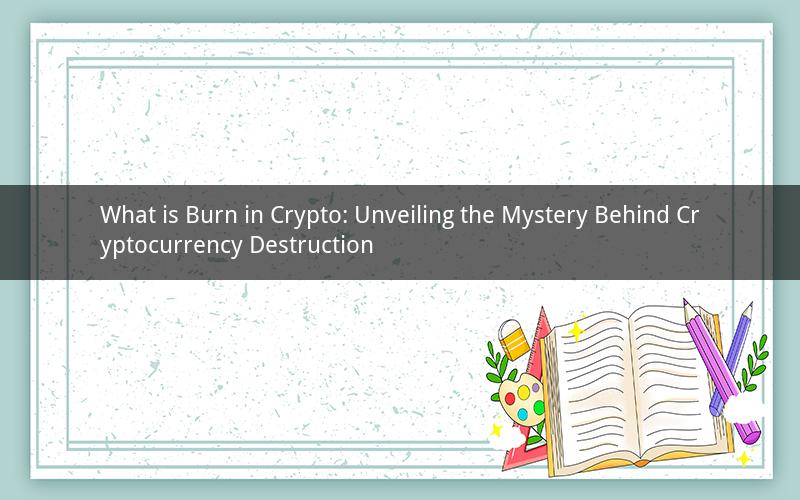
In the rapidly evolving world of cryptocurrencies, a term often heard is "burn." But what exactly is burn in crypto? This article delves into the concept, its significance, and its impact on the crypto market. We will explore how burn works, its role in tokenomics, and its potential effects on the value of a cryptocurrency.
1. What is Burn in Crypto?
Burn in crypto refers to the permanent removal of a specific cryptocurrency from circulation. This process involves destroying or "burning" a certain number of tokens, reducing the total supply of the cryptocurrency. By doing so, the goal is to increase the scarcity of the token, potentially driving up its value.
2. How Does Burn Work?
The process of burning a cryptocurrency typically involves the following steps:
- The cryptocurrency project initiates a burn event, either manually or programmatically.
- The project specifies the number of tokens to be burned.
- The tokens are either transferred to a "burn address" or destroyed using a smart contract.
- Once the tokens are burned, they cannot be retrieved or used.
3. Role of Burn in Tokenomics
Tokenomics is the study of the rules and processes that govern the supply and demand of a cryptocurrency. Burn plays a crucial role in tokenomics, as it affects the overall supply and value of the token. Here's how:
- Decreased Supply: By burning tokens, the total supply of the cryptocurrency decreases. This scarcity can lead to increased demand, potentially driving up the price.
- Increased Value: As the supply decreases, the remaining tokens become more valuable. This can attract new investors and incentivize existing holders to hold onto their tokens.
- Enhanced Utility: In some cases, burning tokens can also increase the utility of the remaining tokens. For example, a project may burn tokens to reward stakers or to limit the ability to perform certain transactions.
4. Potential Effects of Burn on Crypto Value
The impact of burn on the value of a cryptocurrency can vary depending on various factors. Here are some potential effects:
- Immediate Increase: In the short term, a burn event can lead to an immediate increase in the value of the token, as holders believe that the reduced supply will make the token more valuable.
- Long-term Impact: The long-term impact of burn on a cryptocurrency's value is uncertain. While burn can increase scarcity and potentially drive up the price, it can also attract negative attention from regulators or create skepticism among investors.
- Market Dynamics: The overall market dynamics and sentiment can also influence the value of a cryptocurrency following a burn event. If the market is bearish, the increase in value may be limited, while a bullish market could amplify the effects of the burn.
5. Examples of Successful Burn Projects
Several cryptocurrencies have successfully implemented burn mechanisms to increase their value. Here are a few examples:
- Bitcoin (BTC): While Bitcoin doesn't have a built-in burn mechanism, its deflationary nature is a result of the predetermined supply cap. As new blocks are mined, the reward for miners decreases, effectively reducing the supply.
- Ethereum (ETH): Ethereum has implemented a burn mechanism called "Ethereum Gas Fees." A portion of the gas fees paid for transactions on the Ethereum network is burned, reducing the total supply of ETH.
- Binance Coin (BNB): Binance Coin has a built-in burn mechanism, where a portion of the transaction fees is burned. This has led to a consistent decrease in the supply of BNB over time.
In conclusion, burn in crypto is a process that involves the permanent removal of tokens from circulation. By reducing the supply, burn can increase the scarcity and value of a cryptocurrency. However, the impact of burn on a token's value is uncertain and depends on various factors. As the crypto market continues to evolve, burn remains a significant aspect of tokenomics and a tool that projects use to increase the value of their tokens.
Questions and Answers:
1. Q: Can a cryptocurrency be burned manually?
A: Yes, a cryptocurrency can be burned manually by transferring a specific number of tokens to a burn address or using a smart contract to destroy the tokens.
2. Q: Does burning tokens guarantee an increase in value?
A: No, burning tokens does not guarantee an increase in value. The impact of burn on a token's value depends on various factors, including market dynamics and investor sentiment.
3. Q: Can burned tokens be retrieved?
A: No, burned tokens cannot be retrieved. Once they are burned, they are permanently removed from circulation.
4. Q: Is burn the same as a hard fork?
A: No, burn and hard fork are different concepts. Burn refers to the permanent removal of tokens from circulation, while a hard fork involves changing the protocol of a blockchain, potentially altering the existing tokens.
5. Q: Can a burn event lead to a bearish market?
A: Yes, a burn event can lead to a bearish market if the overall market sentiment is negative or if the market is already in a downturn. In such cases, the increase in value following a burn may be limited.